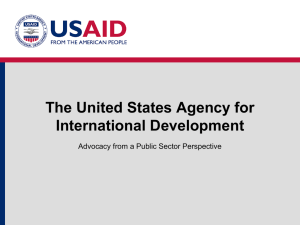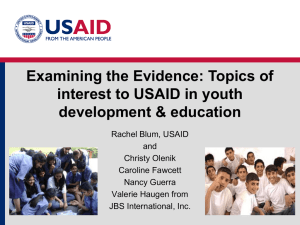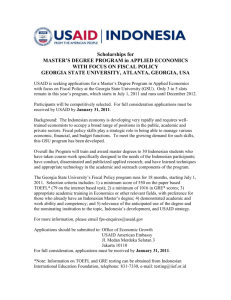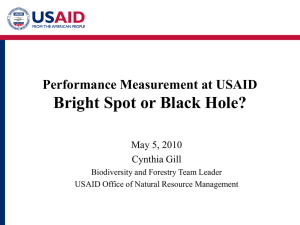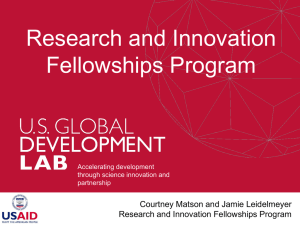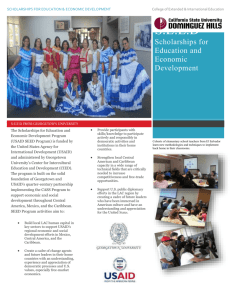Open in new window - Learning Agenda on Local Capacity
advertisement
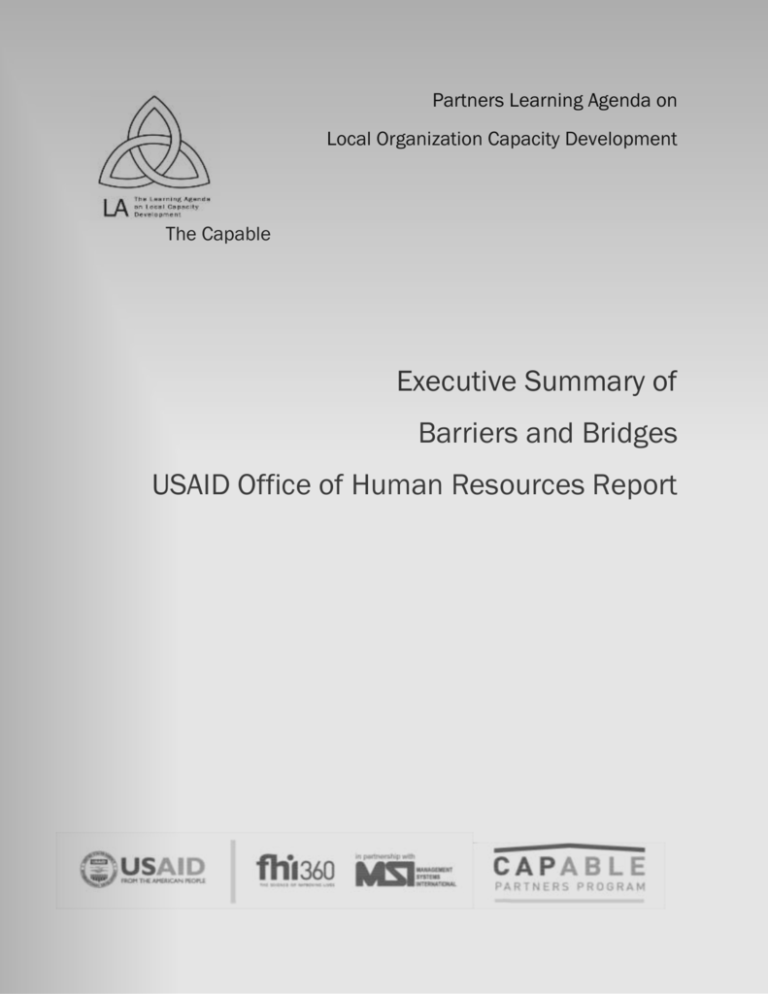
Partners Learning Agenda on Local Organization Capacity Development The Capable Executive Summary of Barriers and Bridges USAID Office of Human Resources Report EXECUTIVE SUMMARY As the Learning Agenda progressed, it became evident that there is a growing gap between USAID’s emphasis on local solutions and the ability of Missions and their staff to undertake approaches that enrich local capacities, both in host governments and civil society. Mission officers often spoke of feeling ill-equipped to employ the “soft” skills of convening, coordinating, communicating and facilitating. There are also Mission staff who, either because of performance assessment criteria or personal preferences, choose to follow predictable career-advancing routines rather than take the perceived risks of local solutions work. With the encouragement of the USAID Counselor, Local Solutions Coordinator and the Acting Director of the Local Sustainability Office, these issues were explored both through a review of studies, reports and documentation, and surveys and interviews with both employees and HR staff. The research identified three areas of concern, each of which has an impact on the way USAID staff work in the field: a) the mechanics of addressing a range of personnel issues; b) the ways in which the Agency defines jobs, identifies competences, recruits, selects, prepares and ultimately rewards its personnel; and c) the confidence that staff feel in the Agency’s leadership. These three areas relate in important ways, and dissatisfaction in one area often leads to unhappiness with one or both of the others. USAID has recognized many of its problems with Human Resources “customer service” and is working to alleviate these, but some appear to be more intractable than others. It appears that USAID policy and initiatives have advanced far ahead of the Human Resource infrastructure. There are 29 different categories of employees and contractors working for USAID with what appear to be serious disparities in the way different groups are treated. Direct hire staff often cite a lack of responsiveness on the part of HR staff, which means they must spend excessive amounts of time resolving what are often very simple issues. But the core issue in this area is seen both in surveys and interviews: employees feel that their performance is not fairly judged and that superior performance often goes unrewarded. This is clearly linked to the second area of concern as well as to the third. USAID Forward with its Implementation Procurement Reform and Local Solutions elements represents a long overdue and important change in Agency priorities. The USAID Administrator has responded to shifts in the relationship between emerging and developed economies by making clear that country ownership (read “local solutions”) is now central to the way in which the Agency will work in future. This is not tinkering; it represents a seismic shift. What has not been as clearly recognized is that moving from rhetoric to action will require a new type of USAID employee. The old USAID placed emphasis on technical skills and their use in overseeing a contracting process that included design, implementation and evaluation. The new USAID must focus on “soft” skills, and officers who place the greatest value on learning as much as possible about the environments in which they work, on developing and maintaining the relationships of mutual respect and trust that are central to an ongoing dialogue that contributes to the changes others – not USAID – have decided are necessary. At present USAID’s personnel systems fall woefully short of the stated goal: HR Report Executive Summary Page 1 “To consistently employ, develop and reward employees who work with skill and commitment to support the strengthening of local organizations that own, resource and sustain inclusive and accountable development.” While there are position descriptions for every backstop, these focus on performance of USAID processes and procedures and draw on technical skills to inform this effort. There is little that is relevant to the enrichment of local capacity. If there is any job analysis or job design it does not relate to development needs; nor is there alignment between recruitment and selection, orientation and training and standards for performance evaluation and management. While USAID contracted for a competence study that has produced hundreds of pages of detail on technical backstops; the materials give short shrift to the cross-cutting, soft competencies that are critical to Local Solutions. Recruitment often paints a different picture than realities of the job. Emphasis is often given to remuneration and other benefits with little focus on the values that are central to the Agency’s Mission and to Local Solutions. Training has been described as looking at PowerPoints of a particular Bureau’s or Office’s website, combined with lectures on how to fill in forms and ensure compliance. In the field the current system’s incentives and rewards are centered around the volume of work handled, whether this is based on the value of the portfolio or the number of reports filed. The final area of concern is the eroded confidence of staff in the Agency leadership. This is most evident in persistent survey findings that employees are not judged in terms of, or rewarded for, the quality of their work. Nothing can contribute more to a highly motivated workforce than widespread employee confidence that good work will be recognized and rewarded. The opposite is true: when good work is neither recognized nor rewarded, it saps the motivation of many employees. One hears the expression, “no good deed goes unpunished.” The “Barriers and Bridges: USAID’s Office of Human Resources” report is organized by two overarching themes: 1) organizational structure and, 2) organizational alignment. First, we present a detailed examination of workforce composition and an account of some major developments over the past few years, particularly in response to a Government Accountability Organization (GAO) investigation. We then consider job-relatedness in light of USAID Forward tenets to facilitate sustainable development in the countries where USAID works. Finally, we offer Recommendations for the Office of Human Resources that are intended to better enable a viable working environment. Essentially, we recommend that USAID make a concentrated effort to review, assess and validate its inventory of human resource documents (i.e. job descriptions and performance reviews) and its inventory of training courses to coordinate better with Agency goals. As well, the Agency would be well-served to validate the competency work and assess affective job qualifications. Likewise, it makes sense to ground all employees with some level of understanding about development theory and development practices. Clearly, employees who are well-informed about the organization are most successful. The good news is systems can be fixed providing leaders are willing to take the time and initiative to re-align the system and hire professionals to assess and make necessary changes that appropriately streamline processes and procedures. Hopefully, our perspective, as outlined in this HR Report Executive Summary Page 2 report and the other reports of the Learning Agenda, helps provide value towards a stronger organizational structure for USAID’s Office of Human Resources. The first step in the process, of course, is a professional needs assessment to help guide the process and ensuing results. Foundations for some of the work may be underway behind closed doors, but they have yet to make their way into the corridors. To this end, it cannot be emphasized enough that the process significantly affects the quality of the results. HR Report Executive Summary Page 3



